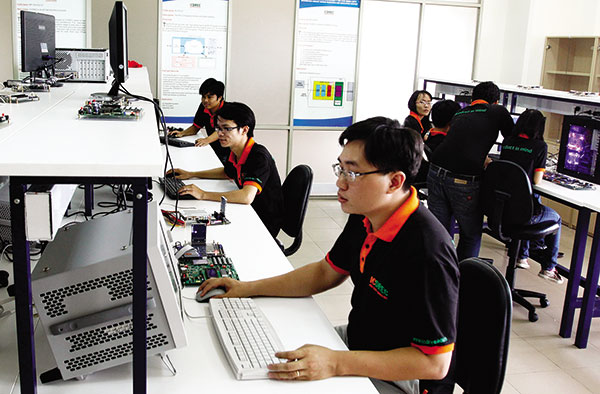High-tech tax cut might follow last year’s IT slash
 |
| Support is growing for a 50 per cent personal income tax cut to be applied to all of the high-tech sector Photo: Le Toan |
Le Bich Loan, deputy chairwoman of the Saigon Hi-Tech Park (SHTP) Management Board, told VIR, “The revision of the tax-related laws, including the Law on Personal Income Tax (PIT), will include a 50 per cent reduction of PIT. The National Assembly will consider the reduction in October’s session.”
Currently, high-tech workers do not enjoy any incentives on PIT, which is a major concern among investors. They have faced challenges in recruiting qualified workers, hindering their businesses’ expansion.
“The cut, if approved, will create a driving force for recruiting workers for high-tech businesses, thus enabling them to attract more foreign investment and increase competitiveness,” she noted.
Last year, after a 50 per cent cut in PIT for IT workers was approved, SHTP and Danang Hi-Tech Park (DHTP) – home to many foreign high-tech investors – made proposals for similar cuts, which should be applied to high-tech workers, to the Ministry of Finance (MoF).
According to Loan, IT is part of the high-tech sector, which also covers electronics, nano-technology, telecommunications, and more. They should all be subject to PIT reductions, not just IT workers.
In related developments, the long-awaited guiding circular for the 50 per cent PIT cut for IT personnel should be finished soon.
“MoF is working on a draft circular guiding the reduction, which will be issued soon,” said Mai Son, deputy director of the Hanoi Taxation Department, while businesses were raising concerns over the issue at last week’s meeting with British Business Group Vietnam (BBGV).
Trinh Thi Thanh Ha, a senior official of British-invested IT company Harvey Nash, said that her company is waiting for the issuance of guiding documents for the PIT cut.
“We have grown by 30 per cent a year on average over the past five years. We are listed among the top 100 taxpayers in Vietnam, with $6 million worth of taxes and insurance a year. We are planning to increase the number of staff to 5,000 from the current 1,600 by 2020,” she said.
Yet according to Ha, Harvey Nash is facing a shortage of employees skilled in IT. “We received 900 job applications from university graduates, but shortlisted just 30.”
It was big news for IT firms in Vietnam when the government issued Resolution No. 41 in 2016, agreeing to reduce PIT of individuals working in the IT industry by 50 per cent.
It is considered one of the most important steps on tax incentives for developing and applying information technology in Vietnam, which still faces a serious lack of skilled IT workforce.
Vietnam has become a magnet for foreign high-tech groups thanks to its incentive policies which give priority in high-tech, technology transfer, and environmental protection.
“In the past, high-tech investors eyed Thailand, China, and the Philippines as attractive destinations. Now Vietnam, where the government has policies to support high-tech development, improved infrastructure, and a stable business climate, has emerged as a potential market for them,” said Pham Dai Duong, Deputy Minister of Science and Technology.
What the stars mean:
★ Poor ★ ★ Promising ★★★ Good ★★★★ Very good ★★★★★ Exceptional
Latest News
More News
- Mitsubishi Estate launches Logicross Hai Phong - a milestone in logistics evolution (November 20, 2024 | 14:32)
- Semiconductor workforce partnerships deliver industry-relevant training (November 20, 2024 | 10:58)
- German Quickpack to invest $31.7 million in Long An province (November 20, 2024 | 09:31)
- Foreign-invested enterprises drive logistics investment in the southeast region (November 20, 2024 | 09:27)
- Chile visit underscores trade benefits (November 19, 2024 | 10:00)
- Trump’s second term impacts sci-tech activities and industry 4.0 technologies (November 18, 2024 | 10:00)
- Vietnam eyes nuclear revival to bolster energy security (November 14, 2024 | 16:46)
- Kyokuyo completes $13.5 million seafood factory in Vietnam (November 14, 2024 | 12:19)
- VinFast receives $3.5 billion funding from Vingroup and Pham Nhat Vuong (November 14, 2024 | 06:38)
- Localities sprint to reach FDI targets (November 13, 2024 | 10:00)















 Mobile Version
Mobile Version